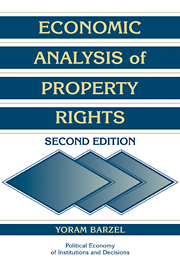Book contents
- Frontmatter
- Contents
- Series editors' preface
- Preface to the second edition
- Preface to the first edition
- Introduction
- 1 The property rights model
- 2 The public domain: Rationing by waiting and price controls
- 3 Contract choice: The tenancy contract
- 4 Divided ownership
- 5 The old firm and the new organization
- 6 The formation of rights
- 7 Slavery
- 8 Wealth-maximizing constraints on property rights
- 9 Property rights and non-market allocation
- 10 Additional property rights applications
- 11 The property rights model: Recapitulation
- References
- Index
7 - Slavery
Published online by Cambridge University Press: 05 June 2012
- Frontmatter
- Contents
- Series editors' preface
- Preface to the second edition
- Preface to the first edition
- Introduction
- 1 The property rights model
- 2 The public domain: Rationing by waiting and price controls
- 3 Contract choice: The tenancy contract
- 4 Divided ownership
- 5 The old firm and the new organization
- 6 The formation of rights
- 7 Slavery
- 8 Wealth-maximizing constraints on property rights
- 9 Property rights and non-market allocation
- 10 Additional property rights applications
- 11 The property rights model: Recapitulation
- References
- Index
Summary
By the beginning of the twentieth century, slavery had largely disappeared. Although the institution is extinct, comparing slaves and free laborers and exploring the forces that permitted slavery to flourish under certain circumstances can shed light on present-day institutions. It is particularly illuminating with respect to the understanding of the evolution of the status of women and general policing and ownership practices.
THE SLAVE CONTRACT
Labor services, routinely exchanged in the market, are subject to contract. The typical contract for the services of a free worker transfers a rather narrow, usually short-term set of attributes from the labor owner to its buyer. Slavery, too, may be viewed as a labor contract – one, however, that gave slave owners extensive rights over their slaves. In the case of forced slavery, the contract extended over the slave's lifetime. The voluntary slave contract typically specified a shorter duration and gave the owner fewer rights over the slave than did the forced slave contract.
Forced slavery was initiated by theft – free people were captured and, as the term suggests, were forced into slavery. Voluntary slavery was the result of an explicit contract – a contract to which both parties agreed, presumably in the belief that signing the contract would be beneficial to each. In some cases voluntary slavery resulted when people who had posted themselves as loan collateral defaulted on their contract and lenders assumed ownership over them. Indentured servitude, a form of voluntary slavery, was a direct method of repaying loans.
- Type
- Chapter
- Information
- Economic Analysis of Property Rights , pp. 105 - 113Publisher: Cambridge University PressPrint publication year: 1997



